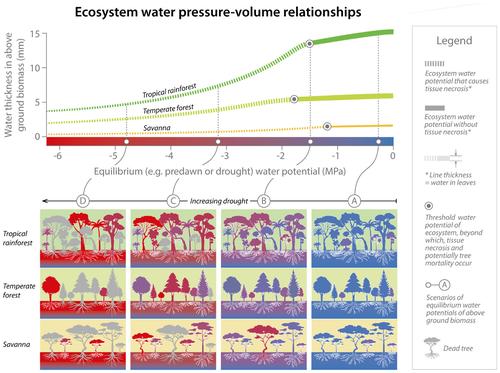当前位置:
X-MOL 学术
›
Glob. Change Biol.
›
论文详情
Our official English website, www.x-mol.net, welcomes your
feedback! (Note: you will need to create a separate account there.)
A Theoretical Framework to Quantify Ecosystem Pressure‐Volume Relationships
Global Change Biology ( IF 10.8 ) Pub Date : 2024-11-06 , DOI: 10.1111/gcb.17567 Oliver Binks, Patrick Meir, Alexandra G. Konings, Lucas Cernusak, Bradley O. Christoffersen, William R. L. Anderegg, Jeffrey Wood, Lawren Sack, Jordi Martinez‐Vilalta, Maurizio Mencuccini
Global Change Biology ( IF 10.8 ) Pub Date : 2024-11-06 , DOI: 10.1111/gcb.17567 Oliver Binks, Patrick Meir, Alexandra G. Konings, Lucas Cernusak, Bradley O. Christoffersen, William R. L. Anderegg, Jeffrey Wood, Lawren Sack, Jordi Martinez‐Vilalta, Maurizio Mencuccini

|
‘Water potential’ is the biophysically relevant measure of water status in vegetation relating to stomatal, canopy and hydraulic conductance, as well as mortality thresholds; yet, this cannot be directly related to measured and modelled fluxes of water at plot‐ to landscape‐scale without understanding its relationship with ‘water content’. The capacity for detecting vegetation water content via microwave remote sensing further increases the need to understand the link between water content and ecosystem function. In this review, we explore how the fundamental measures of water status, water potential and water content are linked at ecosystem‐scale drawing on the existing theory of pressure‐volume (PV) relationships. We define and evaluate the concept and limitations of applying PV relationships to ecosystems where the quantity of water can vary on short timescales with respect to plant water status, and over longer timescales and over larger areas due to structural changes in vegetation. As a proof of concept, plot‐scale aboveground vegetation PV curves were generated from equilibrium (e.g., predawn) water potentials and water content of the above ground biomass of nine plots, including tropical rainforest, savanna, temperate forest, and a long‐term Amazonian rainforest drought experiment. Initial findings suggest that the stored water and ecosystem capacitance scale linearly with biomass across diverse systems, while the relative values of ecosystem hydraulic capacitance and physiologically accessible water storage do not vary systematically with biomass. The bottom‐up scaling approach to ecosystem water relations identified the need to characterise the distribution of water potentials within a community and also revealed the relevance of community‐level plant tissue fractions to ecosystem water relations. We believe that this theory will be instrumental in linking our detailed understanding of biophysical processes at tissue‐scale to the scale at which land surface models operate and at which tower‐based, airborne and satellite remote sensing can provide information.
中文翻译:

量化生态系统压力-体积关系的理论框架
“水势”是衡量植被中水分状况的生物物理相关指标,与气孔、树冠和水力传导以及死亡率阈值有关;然而,如果不了解它与“含水量”的关系,这就不能与地块到景观尺度的测量和建模的水通量直接相关。通过微波遥感检测植被含水量的能力进一步增加了了解含水量与生态系统功能之间联系的需求。在这篇综述中,我们利用现有的压力-体积 (PV) 关系理论,探讨了水状况、水势和水含量的基本衡量标准如何在生态系统尺度上联系起来。我们定义并评估了将 PV 关系应用于生态系统的概念和局限性,在这些生态系统中,水量可以在短时间内根据植物水分状况而变化,而在较长时间尺度上由于植被的结构变化而在更大面积上变化。作为概念验证,地块尺度的地上植被 PV 曲线是根据平衡(例如黎明前)水势和九个地块的地上生物量的含水量生成的,包括热带雨林、稀树草原、温带森林和长期的亚马逊雨林干旱实验。初步结果表明,在不同系统中,储存的水和生态系统电容与生物量呈线性关系,而生态系统水力电容和生理可及储水量的相对值不随生物量系统性变化。 生态系统水关系的自下而上的缩放方法确定了描述群落内水势分布的必要性,并揭示了群落水平植物组织组分与生态系统水关系的相关性。我们相信,这一理论将有助于我们将对组织尺度生物物理过程的详细理解与陆地表面模型运行以及塔基、机载和卫星遥感可以提供信息的尺度联系起来。
更新日期:2024-11-06
中文翻译:

量化生态系统压力-体积关系的理论框架
“水势”是衡量植被中水分状况的生物物理相关指标,与气孔、树冠和水力传导以及死亡率阈值有关;然而,如果不了解它与“含水量”的关系,这就不能与地块到景观尺度的测量和建模的水通量直接相关。通过微波遥感检测植被含水量的能力进一步增加了了解含水量与生态系统功能之间联系的需求。在这篇综述中,我们利用现有的压力-体积 (PV) 关系理论,探讨了水状况、水势和水含量的基本衡量标准如何在生态系统尺度上联系起来。我们定义并评估了将 PV 关系应用于生态系统的概念和局限性,在这些生态系统中,水量可以在短时间内根据植物水分状况而变化,而在较长时间尺度上由于植被的结构变化而在更大面积上变化。作为概念验证,地块尺度的地上植被 PV 曲线是根据平衡(例如黎明前)水势和九个地块的地上生物量的含水量生成的,包括热带雨林、稀树草原、温带森林和长期的亚马逊雨林干旱实验。初步结果表明,在不同系统中,储存的水和生态系统电容与生物量呈线性关系,而生态系统水力电容和生理可及储水量的相对值不随生物量系统性变化。 生态系统水关系的自下而上的缩放方法确定了描述群落内水势分布的必要性,并揭示了群落水平植物组织组分与生态系统水关系的相关性。我们相信,这一理论将有助于我们将对组织尺度生物物理过程的详细理解与陆地表面模型运行以及塔基、机载和卫星遥感可以提供信息的尺度联系起来。


















































 京公网安备 11010802027423号
京公网安备 11010802027423号